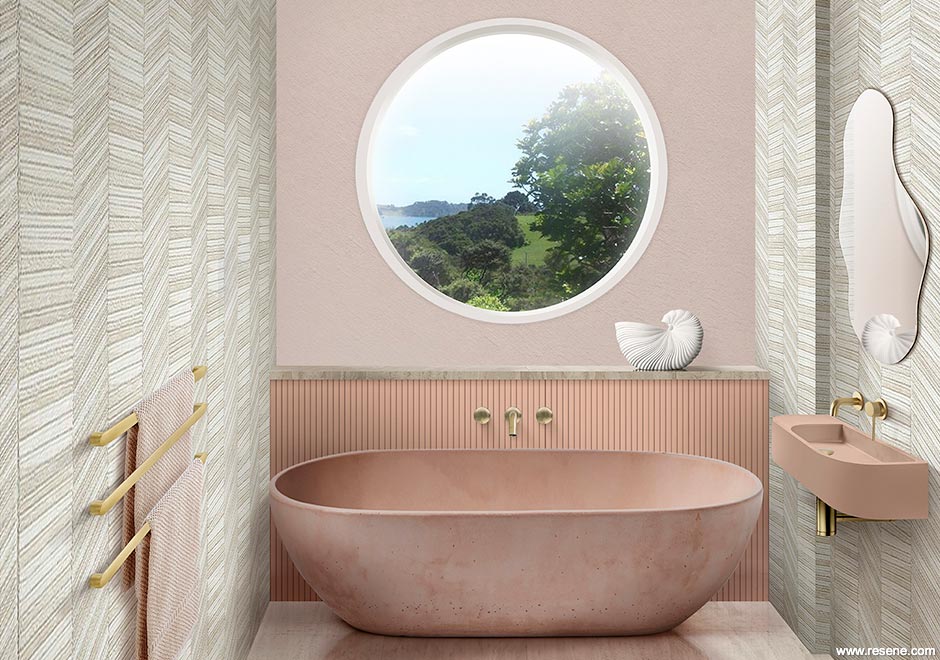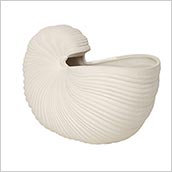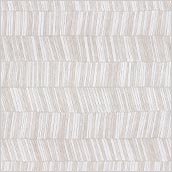From Habitat magazine - issue 34, feature house
Inspired by a woman they had never met, the homeowners of this 1950s home embarked on a colourful journey through time.

Far out. Visitors to Ann Shelton and Duncan Munro's Wellington home often have a physical reaction to their home of many colours. Guests take a step back and gasp at the sheer vibrancy of it all, as if the coral pinks, sunny oranges, lemon sherbet and baby blue shades are affecting them on a cellular level.
The home's bold Resene colour scheme is a shared vision, a collaboration between the home's original owner, Nancy Martin and Czech Republic-born architect, Frederick Ost, who designed the home in 1957. More than 60 years later, using Resene paints and colours, Ann and Duncan painstakingly brought Nancy and Frederick's original colour concept back to life.
Ann and Duncan's efforts were a big success at the recent Resene Total Colour Awards. In the awards, which recognise excellence in colour and paint use, the couple won the Resene Total Colour Heritage Residential Award. They also took away the colour competition's top gong, the Resene Total Colour Master Nightingale Award, named after the Nightingale family, who founded Resene and still runs the company today.
When Ann and Duncan purchased the home in 2013, the house did not have its kaleidoscopic gush factor. The gorgeous rimu ply walls and cabinetry were mostly faithful to the original 1957 design. However, Nancy's original Bauhaus-inspired colour scheme, which saw the walls, floors and cabinetry painted in contrasting colours, had been painted over in the blandest-of-bland whites. And yet, like a Victorian lady revealing a scandalous glance of ankle beneath her skirts, there were signs of the home's colourful bones. Wear and tear to the white surfaces revealed hints of colour, and when Ann and Duncan were rewiring the kitchen, the home revealed its true colours: they discovered ascorbic aquas and peppy oranges beneath the light switches and power-socket covers.
“The vibrancy we discovered was so unexpected. It was truly wild,” says Duncan.
Shortly after Ann and Duncan bought the home, people who had known Nancy started coming out of the woodwork; the intriguing character who created the colourful environment began to reveal herself.
An art collector and musician, Nancy is known for bringing the recorder to New Zealand, hoping the affordable instrument would introduce more children to music. She is also believed to be the first single woman in Wellington to get a mortgage and is listed on the paperwork as a ‘spinster'.


Her connection to the architect Ost was likely through music. Ost and his wife, an orchestral musician, were Jewish and fled the Nazi invasion of Europe, arriving in New Zealand as refugees in 1940.
A friend of Nancy's discovered the architectural plans folded inside an old cookbook and passed them onto Ann and Duncan. The plans showed the bright hues on the walls shaded in colour pencil.
“We started getting a sense of this incredible character and this interesting collaboration between her and Ost. At first, the idea of restoring the original colours was a pipe dream. But, eventually, we saved up money and just went for it,” says Ann, an artist who was so interested in Nancy's house she authored a book on the subject called A Spoonful of Sugar.
“It was a leap of faith as we didn't know what it would be like to live in those colours,” says Duncan, who is a graphic designer and art director.
Duncan mocked up Ost's plans on a computer, and then they searched for the matching colours. “We used so many testpots, but the colours weren't quite right. The modern colours were more intense. The 1957 colours were a bit more muted than the modern shades and had a slightly ambiguous nature. The yellow would look quite green in a certain light, for instance.”
A breakthrough came when Ann posted about their colour-matching efforts on Instagram, which prompted an architect friend to share a hot tip. The friend told her that in the 1950s, there was only one colour chart to choose from – BS2660. Ann and Duncan were able to use the colours from the original chart which their local Resene ColorShop tinted for them.


Entryway: The home's original rimu ply was blonded back in the 1950s to look like white maple. The timber is finished with a clear coat. To protect heritage timber use Resene Aquaclear, a clear waterborne urethane varnish, or Resene Qristal Clear solventborne varnish. Dining area: The original owner Nancy Martin was a musician and well-known artwork collector. The rimu ply walls now showcase its new owner Ann's photographic art, as well as other pieces. "This is a house that loves colour," says Ann, who has held exhibitions in the space. The blonded rimu is protected with clear coats. Use Resene Aquaclear, a clear waterborne urethane varnish, or Resene Qristal Clear solventborne varnish.
The couple decided the complicated colour scheme was a job for the professionals. One painter took one look at the paint plans and turned it down, but AAA Master Painters were intrigued by the story and excited to take on the challenging work. There are 12 different paints used in the kitchen alone, including Resene Mexican Red, Resene Burning Sand, Resene Sea Mist, Resene Primrose, Resene Pearl Lusta and Resene Shadow Green.
Living in the home is a joyful experience, says Duncan, whose favourite shade is the Resene Mexican Red on the kitchen ceiling. Ann prefers the chalky orange of Resene Burning Sand.
“When you jump out of bed in the morning and make a cup of tea, there's a vibrancy and energy to the house. But I think the thing I like the most is the way it all comes together in quite a complex arrangement,” says Ann.
“It's continually surprising, and there's always something new to look at. My favourite part is in the toilet, where the colour from the ceiling carries through the door and to the floor.”
Duncan's home office has Resene Mexican Red on its ceiling, and he thinks the colourful home has rubbed off on his design work. “Before living in this house, I was more tentative and unsure about using colour in my work. I think living here has made me more confident and more aware of the possibilities of different combinations.”




Bathroom: The home still has most of its original in-built cabinetwork. The bathroom vanity is painted in Resene Sea Mist with the left wall in Resene Neptune. Resene Burning Sand carries from the ceiling of the bathroom down onto the door. The blue walls are Resene Neptune. Office: The ceiling of Duncan's office is painted in Resene Mexican Red. The walls are in corkboard and the window trims are Resene Pearl Lusta. The home's exterior is painted in Resene Balderdash.
Ann too has dived deep into colour. Her photography exhibition at the Auckland Art Gallery in 2016, Dark Matters, featured bright walls painted in Resene shades from the Karen Walker Paints collection.
“We feel incredibly privileged to live in this amazing house and to learn about its amazing story.
“There were not many women commissioning architecture in the 1950s. Nancy's house is designed around the living areas, and there are all these feminine touches in the house, such as a built-in ironing board. I still have her old stain-removal chart and meal plans.”
Their next dilemma is tackling the outside of the house and figuring out the original paint shade. “We had better get the scraper out,” says Ann.
To see Ann's book about the Nancy Martin house, visit her website.
Did you know... Resene can tint most older colours even if they are not on a current colour chart? Most Resene colours new and old can be viewed as A4 painted drawdown swatches at your local Resene ColorShop.


Ann and Duncan's home is painted in a scheme similar to the homes of key figures of the Bauhaus movement in Europe. The Bauhaus style favours bold colours, linear style and geometric shapes and was counter to Art Nouveau's curved shapes and botanical influences. Bauhaus masters such as Paul Klee, Wassily Kandinsky and Johannes Itten believed in the sensory qualities of colour. "The deepest and truest secrets of colour effect are, I know, invisible to the eye beheld by the heart alone," wrote Itten.
Choose the right Resene colours and paints for the job.
One of the most striking features of this home are the bright floors. Painting floorboards is a cost-effective way to revamp a room. First, give the floor a thorough vacuum and clean to remove any dirt. For most colours apply two coats of Resene Walk-on, a durable satin flooring and paving paint designed for areas with foot traffic. Then finish with Resene Concrete Wax. Some flooring may need a sealer or primer before topcoating – check with your Resene ColorShop staff the best system for your floor.

Smooth operator
Ann and Duncan's kitchen and bathroom are painted in Resene Lusta-Glo a semi-gloss paint which gives a silky finish ideal for rooms where moisture, drips and grease stains often end up on the walls. It's a durable paint which can be wiped clean. Or you can use a waterborne lower odour version – Resene Waterborne Lusta-Glo or Resene Lustacryl.
Resene was founded in 1946 and 2021 marks the company's 75th anniversary. Resene has records of all its historic colour charts. To look up the BS2660 colour chart, which inspired this home or other historical colour charts, visit www.resene.com/colourarchive, or you can get older colours tinted at your local Resene ColorShop. The Resene Heritage colour chart is also available as a handy colour guide for painting and decorating Early Colonial, Victorian, Edwardian and Dominion era homes.
a neutral organic bathroom with plenty of curves
Interior designer Stacy Heyman of Studio Reno suggests an alternative scheme:

Stacy Heyman
The natural light on the far wall caught my eye. I thought it would be interesting to re-imagine the bathroom with the window as a focal point. Due to the bathroom's small size, I incorporated curves and rounded edges to give the illusion of more space. The rounded battening grounds the bath, drawing your eye up the wall, making the room feel larger. This neutral colour scheme emphasises the greenery through the window and the organic elements such as the nude-coloured bath, the shell ornament, curved mirror and the brushed brass fittings soften the space.
email hello@studioreno.co.nz web www.studioreno.co.nz

Top tip: Resene Sandtex Mediterranean finish is a tough acrylic texture finish which can be applied to many surfaces including plasterboard and concrete. Resene Sandtex can be tinted to a wide range of Resene colours, then brushed onto the surface in a crisscross pattern for a textured effect.

Milani Taps from Abi Interiors.

Ferm Living Shell Pot, from Amara.

Ferm Pond Mirror, from Slow Store.

Navona Bone Vein Tile, from Tile Space.

Resene Wallpaper Collection MO1503, from Resene ColorShops.
a bathroom for relaxation and rejuvenation
Interior designers Kate St James and Catherine Whitting suggest an alternative scheme:

Kate St James / Catherine Whitting
While the home's interior is very much influenced by 1950s style, we re-imagined it in an alternative 'vintage' feel without necessarily being any one specific period. We wanted to create a sense of luxury and wellbeing despite its small size. Being such a small space, we selected a limited palette with a hero colour of Resene Botticelli, a beautiful, relaxing blue/green hue complemented with Resene Concrete and Resene Sea Fog. The quirky, free-standing Rockwell bath stands on blue ball-shaped legs: a reproduction of an antique bath with a modern twist. We chose a complementary Rockwell vanity basin and stand with matching tapware to complete the look.
email: kate@stjameswhitting.com web: www.stjameswhitting.com

Top tip: To paint a concrete floor, prep and seal first then coat with Resene Walk-on and finish with Resene Concrete Wax. For a painted 'tiled' effect paint the basecoat colour, then mask out your grout lines, and paint on your topcoat. Remove the masking tape to reveal your freshly 'tiled' floor
images: Bonny Beattie, Paul McCredie
words: Emma Rawson
illustration: Malcolm White
Search habitat magazine stories
Printed copies of habitat highlights are available from late March 2024 at Resene ColorShops and resellers, while stocks last. You can view back issues of habitat magazine online.
Specifiers:
If you have an idea, project or story that you think would suit habitat, we’d love to hear from you. Please drop us an email with your details and include photos if submitting a project.
Sign up for a DIY card and Save! Australia | New Zealand